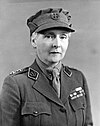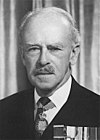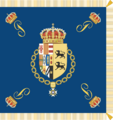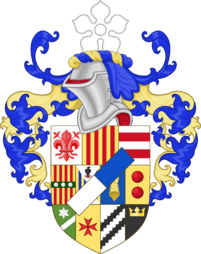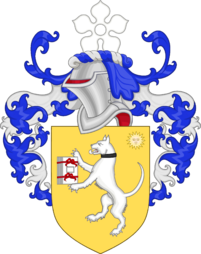Monarchy of Riamo
| Queen of the Riamese Rekuina oe te ma Ramioama'me (Freician) | |
|---|---|
Federal | |
 Royal Arms of Diana II | |
| Incumbent | |
 | |
| Diana II since 8 January 1983 | |
| Details | |
| Style | Her Majesty |
| Heir apparent | Madeline, Princess Royal |
| First monarch | Harold the Bare |
| Formation | 1251 |
| Residence | Royal Palace of Guri Portington Castle |
| Website | monarchy.rm |
The monarchy of Riamo (Freician: Turigu oe Ramio)[a] is the constitutional system of government in which a hereditary monarch is the head of state of the Riamese Federation. The current monarch, Queen Diana II, assumed the throne following the abdication of her mother, Queen Diana I, on 8 January 1983. The Queen's eldest child, Madeline, Princess Royal, is the heir apparent.
The current political system in Riamo was established in 1980. Prior to this, the sovereign wielded greater political power, although they had avoided a direct role in politics since the late nineteenth century. The current constitution, passed that year, removed from the monarch any role in the political system, instituting a representative democracy and parliamentary system based on popular sovereignty.[1]
The principal duty of the monarch, as stipulated in the Federal Constitution of Riamo, is to serve as the symbol of the unity of the Riamese federation and to represent a singular Riamese identity. The Crown undertakes nonpartisan duties in support of national and local causes, which they may delegate to other members of the royal house with the advice and consent of the government.[2]
History
A unified Riamese kingdom was first established in 1251, with the modern-day royal family claiming descendence from the first monarch, Harold the Bare. The monarchy, save for a small number of interregnums, has existed for over 770 years, making it one of the oldest continuous monarchies in the world.
Constitutional role
Riamo's constitution, the Federal Constitution of the Riamese Federation, explicitly declares the monarch's role to be ceremonial in nature. The monarch, according to the constitution, is a "symbol of the unity of the federation and of the oneness of its citizens" and that they "shall undertake their constitutional duties without reference to partisan allegiances, nor shall they engage directly with the governance of the federation".[3] As part of this, the monarch is not nominal chief executive and has no formal political powers exercisable at their own discretion (even theoretically).
The constitution stipulates that the monarch undertakes the following duties:[2][3]
- Presiding over the opening of the two chambers of the federal legislature, the Council of Deputies and the Council of the Federation.
- Calling, proroguing and dissolving one or both chambers of the federal legislature, at the direction of the respective chamber.
- Promulgate, but not enact, laws passed by the legislature.
- Represent the unity of all federal states and act as supreme arbiter between them.
- Meet with the Chancellor on a monthly basis to be briefed on matters of state.
- Receive credentials from ambassadors and sign those of Riamese ambassadors.
- Awarding of national honours.
- Undertaking ceremonial functions at the request of state authorities.
- Chair sittings of the Federal State Council.
The monarch is largely a public, rather than political figure. Professor John Keane, professor of politics at Queen Diana University, observed that the role of the monarch is largely to bring "dignity to the game of politics" and that they are the "announcer, rather than enactor, of government initiatives."[4] The monarch has no right to veto or otherwise refuse the decisions of the government, possessing no autonomy, theoretical or otherwise, in Riamese politics. Nonetheless, all political appointments and the majority of political decisions are made "in the name of Her Majesty", in reference to the position of the monarch as a symbol of federal unity.[5]
Unlike in other constitutional monarchies, the monarch is not commander-in-chief of the Riamese armed forces, a position that lies with the Federal Minister of Defence. Nonetheless, the monarch holds the highest rank in each of the service branches, and has military aids-de-camp and other staff to provide support on military matters.[5]
Position in Freice
Freice is a Country of the Riamese Federation, giving it far-reaching autonomy to the degree that it has been described as a de facto independent state under Riamese protection.[6][7] The Riamese monarch is the most prominent link between Freice and the rest of the federation, and is a focal point of Freician unionist tendencies. Although Freician independence has assumed greater prominence in recent years, the Riamese monarchy (and Queen Diana II in particular) remains popular.[5]
Religious role
The Queen is the head of the Riamese Orthodox Church (ROC), which describes, in its Book of Practices, the Queen as the "envoyee of our Holy Father the Almighty Lord God on Earth" and the "principal representative of Jesus Christ". The monarch's day-to-day role within the church is largely ceremonial, but certain responsibilities are at the sole prerogative of the Queen as head of the church. These include the appointment of the primate and the approval of church laws. Appointments within the church not made by the Queen personally are made "in the name of the Most Holy envoyee of the Most Holy and Almighty Father, our Sovereign Lady Queen, Supreme Head of the Holy Church of God."
Oath of allegiance
The oath of allegiance in Riamo incorporates reference to the monarch as the principal representative of the unity of the federation:
"I, "name", do solemnly swear (or affirm) true faith and allegiance to the Federal Constitution of the Riamese Federation and to all laws, customs, and usages therein provided, and to recognise Her Majesty Queen Diana The Second, Her heirs and successors, as Head of the Associated States of the Federation. So help me God.""
Style
The monarch holds different titles depending on the context of its use. The title of the Sovereign as head of state is granted by the constitution—"Diana the Second, by the Grace of God and the Constitution of the Federation, Queen of the Riamese, Sovereign of the Kaldaic Islands and the Outliers, Ruler of the Oceans and the Seas, Defender of the Faith."
In each constituent state, the monarch is styled "The Queen in Right of [State]" or "Her Majesty in Right of [State]", in particular reference to any role she has on a subnational level. In Riamo's Kaldaic territories, she is informally referenced as "The Queen, Our Sovereign" or "Diana II, Queen and Sovereign".
The Queen's consort, Philip, is titled as King, with the style of Majesty. However, he is not a King regnant and does not rule as co-monarch alongside his wife. Moreover, the King Consort is styled "King Consort of Riamo" rather than "King of the Riamese".
List of monarchs
| Name and reign | Portrait | Birth | Marriage(s) | Death | Succession right |
|---|---|---|---|---|---|
| Charles IV Charles Henry Frederick George 18 December 1899 – 27 March 1912 (12 years, 101 days) |
1 February 1869 Royal Palace of Guri Son of Alexander, Hereditary Prince of Riamo and Diana, Dowager Lady Harmon |
Margaret of Ausy Guri Cathedral 9 April 1889 4 sons, 1 daughter |
27 March 1912 Royal Palace of Guri Age 43 |
Grandson of Charles III | |
| Gregory Gregory Charles Henry 27 March 1912 – 4 August 1918 (6 years, 131 days) |
7 June 1892 Royal Palace of Guri Son of Charles IV and Margaret of Ausy |
N/A | 4 August 1918 Queen's House Age 26 |
Son of Charles IV | |
| Diana I Elizabeth Diana Lilian 4 August 1918 – 23 September 1961 (43 years, 51 days) |
1 September 1887 Royal Palace of Guri Daughter of Alexander, Hereditary Prince of Riamo and Diana, Dowager Lady Harmon |
General Lord Charles Hedren Guri Cathedral 4 June 1908 (d. 1910) |
23 September 1961 Queen's House Age 74 |
Sister of Charles IV | |
| Frederick Frederick Charles Augustus 23 September 1961 – 8 January 1983 (15 years, 108 days) |
16 March 1895 Bourne House Son of Prince Frederick and Lady Louisa Augusta-Bremn |
Lady Elizabeth Mount Adams Guri Cathedral 29 July 1949 1 sons, 3 daughters |
8 January 1983 Royal Palace of Guri Age 81 |
Grandson of Charles III; cousin of Diana I | |
| Diana II Diana Elizabeth Maria since 8 January 1983 (41 years, 264 days) |
16 May 1951 Royal Palace of Guri Son of Frederick and Lady Elizabeth Mount Adams |
Peter Normington Guri Cathedral 25 February 1986 2 sons, 2 daughters |
Living Age 73 |
Daughter of Frederick |
Royal Family
In Riamo, all members of the ruling dynasty who hold the title Prince or Princess of Riamo are said to be members of the Riamese royal family. Individuals who do not possess the title but who are still members of the family, are regarded as extended members of the family. Extended members may possess other titles or be without title.
Main members
The Riamese royal family includes:
- HM The Queen ("Queen Diana II")
- HM The King Consort ("Peter", The Queen's husband)
- HRH The Princess Royal ("Princess Madeline", The Queen's elder daughter)
- HRH Prince Laurence of Riamo (The Queen's son-in-law)
- HRH Prince Arthur of Riamo (The Queen's grandson)
- HRH Princess Arthur of Riamo ("Maria", Prince Arthur's wife)
- HH Princess Isabel of Riamo (The Queen's great-granddaughter)
- HRH Prince William of Riamo (The Queen's elder son)
- HRH Princess William of Riamo ("Leonora", The Queen's daughter-in-law)
- HRH Prince Clement of Riamo (The Queen's younger son)
- HRH Princess Alexina of Riamo, The Honourable Lady Medlin-Sefa (The Queen's younger daughter)
- HRH Prince Alexander of Riamo (The Queen's younger brother)
- HRH Princess Alexander of Riamo ("Clara", The Queen's sister-in-law)
- HRH Princess Lilias of Riamo, The Honourable Lady Prisk (The Queen's younger sister)
- HRH Princess Amelia of Riamo, The Honourable Lady Emerton (The Queen's youngest sister)
Extended members
The extended Riamese royal family which includes people who do not hold the title of Prince or Princess of Riamo but have close connections to the Queen. This includes those who hold the title "Prince or Princess of Parmy-Sefa":
- HH Princess Elisabeth of Parmy-Sefa (Prince and Princess William's daughter)
- HH Princess Catherine of Parmy-Sefa (Prince and Princess William's daughter)
- HH Prince Charles of Parmy-Sefa (Prince Clement's son)
It also includes those with no title at all:
- Thomas Medlin-Sefa (Princess Alexina and Thomas Medlin-Sefa's elder son)
- James Medlin-Sefa (Princess Alexina and Thomas Medlin-Sefa's younger son)
- Maria Medlin-Sefa (Princess Alexina and Thomas Medlin-Sefa's daughter)
- Samuel Prisk (Princess Lilias' husband)
- John Prisk (Princess Lilias and Samuel Prisk's elder son)
- Richard Prisk (Princess Lilias and Samuel Prisk's younger son)
- Hugh Emerton (Princess Amelia's husband)
- Marie-Elisabeth Emerton (Princess Amelia and Hugh Emerton's daughter)
- Sophie, Princess Clement (Prince Clement's ex-wife)
Royal arms and standard
The Queen is represented by a royal standard, which is flown to signify the monarch's presence. It features the monarch's personal cypher on a blue field, along with their cypher in each corner. The royal consort and heir apparent may also use personal standards, differenced with a border.
Armorial
Members of the royal family may use a personal coat of arms. The Queen, as head of the royal house, uses a shield featuring the arms of the historic Riamese kingdoms in eleven quarterings. At the base of the arms is a point entée bearing the cinquefoil as used on the Seal of Riamo.
Other members of the family use the same arms, but differenced. Children of the sovereign bear the arms differenced with a three-point label, whilst grandchildren difference their arms with a five-point label. The label (always white) bears individual marks based on the armiger's position: two crescents on the first and third points (second child of the sovereign), a mullet (star) on the second point (third child of the sovereign), a martlet (bird) on the first and third points (fourth child of the sovereign), and a annulet on the first and third points (fifth child of the sovereign). The heir to the throne bears an uncharged label. Grandchildren bear a label charged with marks based on their parents' arms.
Siblings of the sovereign feature a bordure, either coloured or charged.
See also
Notes
References
- ↑ "RIAMO". AIP Encyclopaedia of National Governments. 4 March 2019. Retrieved 13 January 2021.
- ↑ 2.0 2.1 "Role of the Sovereign". Riamese Monarchy. 12 June 2015. Retrieved 16 March 2016.
- ↑ 3.0 3.1 "Constitution". Riamese Federal Government. 7 January 2014. Retrieved 22 August 2014.
- ↑ Keane, John, "Constitutional Republicanism and the Riamese Monarchy", Journal of Politics and Constitutional History, 8, no.3 (2019), pp.55-82
- ↑ 5.0 5.1 5.2 "Freice: Kana proposes viceroy". Riamo News. 3 December 2022. Retrieved 3 December 2022.
- ↑ "Council > Freice-Riamo Relations". Government of Freice. Retrieved 19 July 2016.
- ↑ "Can can Freice not do?". Riamo News. 8 January 2021. Retrieved 4 March 2021.
External links



